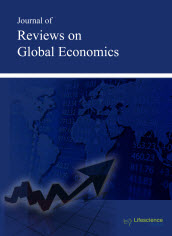jrge
Abstract: How the Quantitative Easing Affect the Spillover Effects between the Metal Market and United States Dollar Index?
|
|
Abstract: This study explores both return and volatility spillover effects, the co-integration relation and the correlative relationship between the metal market in London metal exchange and United States exchange rate market, and the risk premium and leverage effect in each of these two markets for the periods before and during quantitative easing (QE). Empirical results show that, as the QE is executed the risk premium in US exchange rate market will disappear; and the speed and direction of the adjustment back to equilibrium respectively becomes greater and is reversed for the co-integration relation in metal market. Regarding these two markets only the return spillover effect is affected, and the degree of negative correlative relationship becomes more obvious as the QE is executed. Keywords: Spillover effect, United States dollar index, Metal market, Quantitative easing.Download Full Article |
Abstract: Global Financial Crisis of 2008, Asymmetric Effects of Exchange Rate Changes, and Stability of the Demand for Money in Japan
|
|
Abstract: We wonder if Global Financial Crisis of 2008 affected stability of the demand for money in Japan. In testing this hypothesis we deviate from previous studies which either excluded the exchange rate from money demand function in Japan or have not been able to find any significant relation between the exchange rate and the demand for money. While we address stability of the demand for money, we show that failure to find a cointegrating relation or significant effects could be due to assuming a linear model in which exchange rate changes have symmetric effects. Once we consider a nonlinear ARDL approach of Shin et al.’s (2014), we show that not only variables in the money demand are cointegrated but exchange rate changes have asymmetric effects. In the long run, while appreciation of yen has significantly positive effect on the demand for money in Japan, depreciation does not. We also find a stable money demand which was not affected by 2008 financial crisis. Keywords: Nonlinear ARDL Approach, Symmetry versus Asymmetry, Money Demand, Japan.Download Full Article |
Abstract: Fairness and Ethics in Spending
|
|
Abstract: Islamic faith and the ethical dimensions of the individual and the community have a significant role in guiding economic behavior by connecting the worldly life to the hereafter. In the Islamic economics paradigm, by relating ethics to the economic behavior of spending, we exhibit the good (bad) attributes of ethical (unethical) behavior. In this paper, we contribute to developing a measure of the overspending and underspending that allows testing the presence of wastefulness and niggardliness. Keywords: Consumer behavior, Spending, Ethical utility, Earning layer, Belief holding, Threshold spending, Islamic economics.Download Full Article |
Abstract: PLS Finance and Monetary Policy: A New Measure Mooted
|
|
Abstract: Islam banishes interest. This raises two questions contextual to Central Banking. First, can Islamic banks create credit like the conventional? We shall argue that Islamic banks cannot avoid credit creation; an imperative for staying in the market where they operate in competition with their conventional rivals. Evidently, the interest rate policy would not be applicable to them as a control measure. This leads us to the second question: What could possibly replace the interest rate for Islamic banks? In reply, the paper suggests what it calls a leverage control rate (LCR) as an addition to Central Banks’ credit control arsenal. The proposed rate is derived from the sharing of profit ratio in Islamic banking. It is contended that the new measure has an edge over the old fashioned interest rate instrument which it can in fact replace with advantage. It can possibly be a common measure in a dual system. Keywords: Central banking, Credit creation, Leverage Control Rate (LCR), Islamic banks, Profit sharing.Download Full Article |























